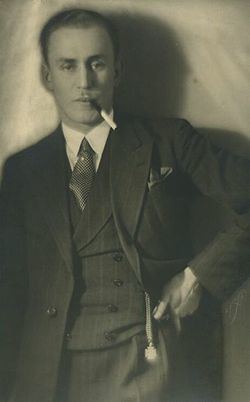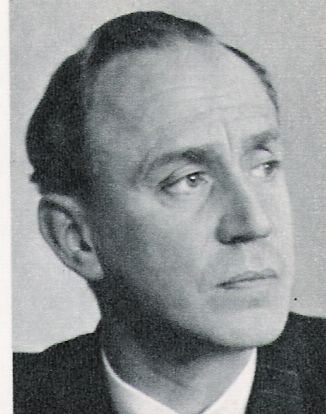Name Olavi Paavolainen Role Essayist | Education University of Helsinki | |
 | ||
Books Kolmannen valtakunnan vieraana | ||
Olavi Paavolainen (1903 - 1964) was a Finnish writer, poet, essayist and journalist. During his early years, he went under the pseudonym of Olavi Lauri. Paavolainen was the central figure of the literary group Tulenkantajat ('The Flame Bearers') and one of the most influential literary opinion leaders between the two World wars in Finland. He represented liberal and European-oriented views of culture and had an eclectic eye for new ideas.
Contents

In the late 1920s Paavolainen wrote essays that praised urban life, technology, and roaring cars in his works centering on modernism. He was inspired by authors like the Italian Futurist poet F.T. Marinetti (1876-1944) and the French intellectual André Gide (1869-1951). His first book Nykyaikaa etsimässä (1929, 'In search of Modern Times'), contained a collection of his essays from the 1920s. In the 1930s, he became focused on the rise of authoritarian regimes in Europe and their promises to create a new man and new society. As a result of his visits to Nazi Germany (1936) and South America (1937), he wrote three essayistic books titled Kolmannen Valtakunnan vieraana (1936, ‘As a Guest of the Third Reich’), Lähtö ja loitsu (1937, ‘Departure and Spell’) and Risti ja hakaristi (1938, 'Cross and Swastika’), known together as the Pako pimeyteen (‘Escape into Darkness’) trilogy. The overall theme of the books was the nature of the political and cultural changes that had engulfed his contemporary society. A planned book about his visit to the Soviet Union (1939) was halted by the outbreak of the Second World War. His last book, Synkkä yksinpuhelu (1946, 'A Solemn Monologue') was largely based on his diary notes from 1941-1944 when he served in the Finnish Army.

Early life

Olavi Paavolainen was born in Kivennapa, Carelia, in the Grand Duchy of Finland in 1903. Paavolainen descended from a family of civil servants and soldiers. His father, Pietari (Pekka) Paavolainen, was a lawyer and Member of Parliament and his mother was named Alice Laura (Löfgrén). In 1914, he moved to Helsinki where he started to write poems already at the age of twelve. He later studied aesthetics and literature at the University of Helsinki from 1921 to 1925, but without graduating. While studying at the university, Paavolainen already started to publish critics and poems.
The young poet Katri Vala, whose first book appeared in 1924, was instrumental in encouraging Paavolainen in his choice of literary career. In the same year Paavolainen contributed to the anthology Nuoret runoilijat I ("Young Poets I") under the pseudonym Olavi Lauri, which he used some years. During this early period, Paavolainen was interested in nudism, and he deemed the works of Comtesse de Noailles important for his development. In his letters to Vala, Paavolainen also expressed his interest in fine suits, and mocked himself as a dandy. However he was heterosexual, particularly attracted to older powerful women, and among his friends was the notorious Minna Craucher, who had contacts to the far right-wing Lapua movement. Craucher was murdered in 1932. On the other hand, the communist politician Hertta Kuusinen was Paavolainen'sclose friend during his later years. The relationship with writer Helvi Hämäläinen was very important for Paavolainen during the war years. Hämäläienn has described Paavolainen as the narsistic character Arthur in her novels "Decent tragedy" and "Lost garden".
Late 1920s
In 1927 Paavolainen traveled to Paris and wrote his impressions to the magazine Ylioppilaslehti, edited by Urho Kekkonen. His first book, Valtatiet ("Highways"), cowritten with Mika Waltari was published in 1928, a poem which was a youthful manifest of machine romanticism. The poet speeds through the countries of Europe in his red Fiat car, which explodes into a star over the Sahara Desert.
Valtatiet, inspired by Marinetti's automobilism and Futurist manifestos, was followed in 1929 by a concoction of essays, Nykyaikaa Etsimässä ("In search of modern time") which centers on the modernization of Europe after the atrocities of World War I. During this period, 1928–29, he also served in the Finnish Army. When the writer Pentti Haanpää attacked the army in his book Kenttä ja kasarmi (1928), Paavolainen considered its views on military life exaggerated and malicious.
1930s
In 1930 Paavolainen had become for a short time the editor of the magazine Tulenkantajat, but he was encountering some financial difficulty, and as a freelance writer he had no regular income. In the conservative atmosphere of the 1930s Paavolainen felt himself personally lonely. He made a journey to England in 1932, but did not have the energy to write the travel book which his publisher expected. In 1930 his father died, and Paavolainen confessed to experiencing an Oedipal dream in which from that point on he became a believer in Freud.
In the early 1930s Paavolainen discontent with what he viewed as the socio-economic backwardness of Finland declared it was time to "give voice to the new era of speed, mechanization, cosmopolitanism, collectivism, and the European experience." His next book, Keulakuvat, a collection of poetry, appeared in 1932, and Suursiivous the same year.
From 1933 to 1934 Paavolainen worked at an advertising agency in Helsinki, and then in 1935 in Turku as the advertising manager of a clothing company, always being interested in elegant fashion. Later in the fall of 1935 he resigned and returned to Helsinki without any work. In 1936 he made a journey to Nazi Germany and witnessed the Nuremberg Rally. In his travel book Kolmannen Valtakunnan vieraana depicts both his enchantment and critical impressions of different elements of Nazism:
Whilst in Germany, Paavolainen met Nazi politicians, writers, young enthusiasts, and intellectuals and attended events where prominent Nazi politicians such as Joseph Goebbels gave speeches. The experience was documented in Kolmannen Valtakunnan vieraana:
Kolmannen Valtakunnan vieraana was a major success, but it was also seen as ambiguous and was widely debated when it was published in December 1936.
With the financial assistance of the publishing company Gummerus, Paavolainen was able to travel to South America in 1937. He visited destinations in Brazil, Argentina and Paraguay and wrote about his experiences in the books Lähtö ja loitsu and Risti ja hakaristi. Shortly before the Winter War, in 1939, he also travelled in the Soviet Union and greatly admired Stalin's modernism in the city.
In the late 1930s Paavolainen had a close relationship with the writer Helvi Hämäläinen; she was the only woman, "who dared to leave him", as Paavolainen later said and they separated in 1941.
1940s
During World War II Paavolainen served at the Information Department of the Headquarters. He was posted after the outbreak of the Winter War to Mikkeli in eastern Finland, as adjutant to an infantry general and visited Vienola in 1944. His childhood home with its famous palm tree room was destroyed. It was the last time he saw his place of birth. Paavolainen's critical World War II diary Synkkä yksinpuhelu, published in 1946, was attacked domestically because of its opposition and surmounted opinions of the war between Finland and the Soviet Union, and Paavolainen's suggested anticipation of the defeat in the early war years. While Paavolainen was during 1940-1941 enthusiastic about an expected German victory and had contacts to the Nazi-inspired Suomen Kansallissosialistinen Työjärjestö (SKT, 'National Socialist Worker's Organization of Finland), he soon started to have reservations about Finland's alliance with Germany as the tide of the war turned against them. After Synkkä yksinpuhelu received major criticism in Finland, Paavolainen effectively ended his career as a publishing writer.
In 1945 Paavolainen married poet Sirkka-Liisa Virtamo; but the marriage ended officially eight years later in 1953.
1947: A change in direction
In 1947, Paavolainen was appointed as director of theatre department of the Finnish Broadcasting Radio by his acquaintance Hella Wuolijoki, who was dismissed in 1949. Under Paavolainen, who reluctantly accepted the work, the radio theatre programs gained a wide audience. In the mid to late 1950s he had a close relationship with Hertta Kuusinen, the politician and parliament member, daughter of Otto Ville Kuusinen, who was one of the top leaders of Communist Party of the Soviet Union.
During his last years Paavolainen often complained that he felt exhausted and drank heavily, and occasionally didn't bother to go to work, and nostalgically planned to write the history of Tulenkantajat.
In 1960 Paavolainen received the coveted Eino Leino award personally from President Urho Kekkonen congratulated him, calling him a "man pushed into oblivion".
Olavi Paavolainen died of alcoholism on July 19, 1964 at Kivelä hospital in Helsinki. He is buried in the Hietaniemi Cemetery in Helsinki.
Aftermath and legacy
In 1974, Paavolainen's friend Matti Kurjensaari published a vivid portrait on him. The account encountered significant objection from Paavolainen's heirs, which exhausted Kurjensaari to the point that he almost didn't publish the book. In 1991, another bibliography by Jaakko Paavolainen was published, this time with greater acknowledgment and reception, giving much new information about the childhood and youth of the author. In the autumn of 2014, two new biographies of Paavolainen by Panu Rajala and H. K. Riikonen were published. The Pajala books focuses a lot in Paavolainen's relationships with women. The Riikonen book is drawing a portrait using Paavolainen's own writings as material.
